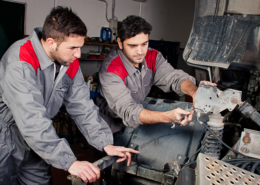Goals Top Dealers are Making for 2018
Top performing dealers know the importance of setting goals. Communicated clearly, goals help employees see the big picture and focus on what’s really important. They provide a benchmark to measure progress and provide incentives for your employees that go above and beyond.
Set realistic goals, keep re-evaluating, and be consistent. – Venus Williams
It’s not too late to set goals for 2018, or to re-examine goals you set earlier. Take the lessons learned in 2017 and incorporate them into this year’s plans. To help you out, here are 6 goals dealers are striving to reach this year.
Reduce Conflict Between Parts and Service Departments
Dealers regularly struggle with the conflict between the parts and service departments. Whether it be buying decisions for specific parts and quantity, using OEM vs aftermarket, or maintaining inventory at cost-effective levels, the goals of the two departments are often at odds with each other.
Top dealers agree that a cultural shift can move the departments away from conflict and toward cooperation and higher performance. If the parts department adopts a strategy that recognizes service as their most important customer, and the two departments develop shared goals based on their joint needs, the adversarial relationship will diminish. The dealership will no longer have to deal with the same level of service delays, finger pointing, and customer frustration. Weekly monitoring to fine-tune parts orders based on known service needs at specific times of year as well as anticipated hourly usage can help optimize parts fill rates and service utilization.
Encourage Employees to Allow and Accept Feedback from their Peers
Dealers are assessing the impact that communication and corporate culture have on business results. They recognize new employees may be intimidated or feel uncomfortable sharing new ideas or observe senior team members stifle opportunities by saying ‘it’s not the way we do things here’.
These behaviors can lead to disengagement that negatively impacts growth. Teams become less efficient, and tensions between employees reduce opportunities for innovation. It limits the ability to meet individual, team, department and dealership goals.
To improve communication between employees, dealers are investing in formal training programs that focus on improving communication and reducing tension often experienced when delivering feedback. Team meetings include more time to discuss issues, problem solve and provide feedback on achieving goals. The result is a more cohesive and engaged workforce that provides better customer experience and is actively involved in improving the company.
Restructure Compensation Plans to Include Personal, Department, Dealer, Enterprise and Customer Experience Goals
Compensation plans are as unique as your business. They include goals for individual and department performance and may also include dealer and enterprise goals. Challenges arise when the emphasis on individual and departmental goals inhibit, if even subconsciously, employees from acting in the best interests of the customer or the company.
Top dealers want customers for life, not just a quick sale. They recognize the importance of moving to a customer-focused culture and include customer experience goals in all compensation plans. This aligns performance goals with a culture of customer experience excellence and reduces conflicts between departmental goals.
When you sit down to begin this work remember to include HR from the start. This ensures hiring and job descriptions reflect your customer-driven culture. Capture two or three years of customer satisfaction/experience and growth scores to set realistic yet challenging goals. Communicate quarterly to show how your employees directly influence company growth and customer loyalty.
Improve employee engagement and deal with “terrorists” within the organization
You know this employee. They are proficient in the technical aspects of their job but they do only what is needed. Their negative attitude, constant chatter and criticism poisons the environment and brings everyone down. This one person stifles growth due to their negativity and unwillingness to change.
You want a team that is excited about being at work and willing to go the extra mile for the customer. The longer the poison is allowed to spread the greater the disengagement and the harder it will be to re-engage your employees.
When faced with an employee like this sometimes the best option is to let them go. If you think the employee is worth saving you can give the “terrorist” an ultimatum, e.g., change your ways or you’re out. One dealer group did just this, and with support from supervisors, the employee converted and re-engaged.
Understand Customers Better
With customer experience the new competitive differentiator in the market, it is more important than ever for dealers to understand every customer. And it goes beyond knowing what the customer currently needs. When you know and understand your customer and their challenges you can anticipate their future goals and needs, thereby exceeding their expectations. This is a key step in becoming their dealership of choice.
Dealerships are going beyond the one-size-fits-all for customer contact. They are setting goals to monitor social media and reach out and respond to all online feedback. Managers are assigned to contact all major customers on a semi-annual basis as well as making one site visit per year. Dealerships are investing in training staff on how to ask for and record feedback. And they are committed to following up on each returned survey to close the loop. Finally, dealers are committing to hold an annual customer roundtable or event where they can hear first-hand about their customer’s ideas and thoughts.
Establish a Dedicated Key Accounts Manager for Key Customers and Incorporate Customer Annual Reviews
Dealerships are keenly aware that it costs more to get a new customer than it does to retain an existing customer. They are re-energizing their customer loyalty and providing exceptional customer service by dedicating an individual to oversee key big accounts. By making regular check-ins to uncover little concerns before they become issues, or providing updates on a recall, update, or parts or service order, your customer will quickly realize their concerns and needs are important.
Dealerships know that seeing the customer in their environment is key to truly understanding their needs. By getting out and spending time at their place of business at least once per year, you can stay close to your customer, learn their future goals and take a pulse of the relationship. As a result, they will be more willing to share the pain points with dealership processes.







